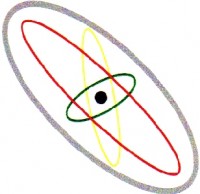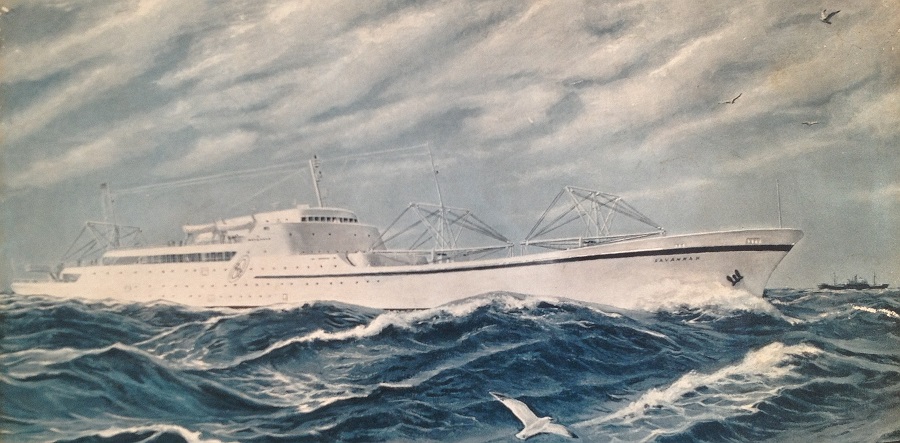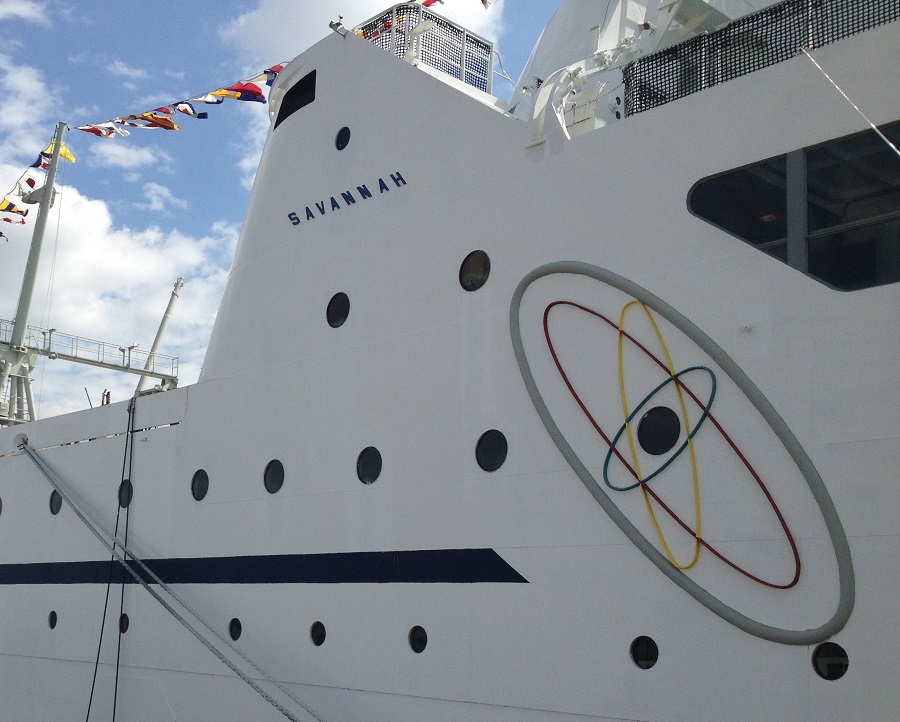July 1959: Savannah Afloat!
 The last half of the 1950s was a time of great promise for the concept of atomic-powered commercial ships. The idea was given real political momentum (which it very much needed) in 1955 when President Eisenhower formally proposed construction of such a ship by the United States. In July 1956, Congress passed Public Law 848, authorizing the actual engineering and construction of the ship.
The last half of the 1950s was a time of great promise for the concept of atomic-powered commercial ships. The idea was given real political momentum (which it very much needed) in 1955 when President Eisenhower formally proposed construction of such a ship by the United States. In July 1956, Congress passed Public Law 848, authorizing the actual engineering and construction of the ship.
Work progressed quickly, but not as originally envisaged in all quarters. The original idea floated in the Joint Committee on Atomic Energy (JCAE) was that a bulk freighter be built-this would theoretically provide the best economic return. Eisenhower wisely understood that the true commercialization of nuclear-powered commercial shipping by the government (with considerable private investment and development, of course) would require both a demonstration project and the signing of trade deals with other nations to allow nuclear ships to dock for the transfer of cargo. Without these agreements, there could be no nuclear merchant flee. Thus, Eisenhower proposed (and got) a combination working vessel and show boat.
In May 1958, the keel of what had now been named the NS SAVANNAH ("NS" for Nuclear Ship) was laid down at New York Shipbuilding, and construction of the vessel began in earnest. Babcock & Wilcox (now BWX Technologies) provided the nuclear steam supply system, DeLaval provided the steam turbines, Westinghouse built much of the reactor control equipment, and General Electric made the control rod drives. Indeed, dozens and dozens of companies vied for the many contracts required to construct the vessel, right down to Raytheon, which provided an advanced brand-new RadaRange for the ship's ultra-modern galley. (This was the first type of microwave oven manufactured, and it was cooled by the ship's chill water system.)
 NS Savannah Launch Ceremony Brochure cover, 1959. Courtesy Will Davis / N/S Savannah Association, Inc.
NS Savannah Launch Ceremony Brochure cover, 1959. Courtesy Will Davis / N/S Savannah Association, Inc.NS Savannah Launch Ceremony Brochure cover, 1959. Courtesy Will Davis / N/S Savannah Association, Inc.
The momentous day of July 21, 1959, saw the ship launched at New York Shipbuilding, with Mamie Eisenhower presiding as the sponsor. The ceremony went off as planned as did the launch. In fact, this was the beginning of an almost completely smooth history for the world's first civil (that is to say, non-military) passenger/cargo vessel.
What's most astonishing today about the early history of this significant vessel is the short time frame it took to go from concept to voyage. Only three years elapsed between the Congress funding the design and construction of the ship to its actual launch. Admittedly, some of the brevity of this time period can be credited to naval architect George Sharp and Associates having begun with the U.S. Maritime Administration's "Mariner" class vessel design and modifying it (quite heavily, in point of fact) to accept a nuclear power plant, but the development and construction of a completely new shipboard nuclear plant in that short time period is by itself astonishing.
The American Nuclear Society in 1991 designated the NS SAVANNAH as a Nuclear Historic Landmark. The award was presented to the ship while at Patriot's Point Naval Museum. The Nuclear Historic Landmark Award "identifies and memorializes sites or facilities where outstanding physical accomplishments took place, were instrumental in the advancement and implementation of nuclear technology and the peaceful uses of nuclear energy." While the construction and operation of the NS SAVANNAH did not ultimately lead to a fleet of U.S.-flagged commercial nuclear ships, it did prove that the design and construction of a safe, reliable ship (for SAVANNAH was both in service) could be accomplished in an incredibly short time, given the will.
 Futuristic atom insignia, on port side of NS SAVANNAH. Photo courtesy N/S SAVANNAH Association, Inc. The ship sits today at the Canton Marine Terminal, Baltimore and has just received the first funding authorization to begin formal nuclear decommissioning.
Futuristic atom insignia, on port side of NS SAVANNAH. Photo courtesy N/S SAVANNAH Association, Inc. The ship sits today at the Canton Marine Terminal, Baltimore and has just received the first funding authorization to begin formal nuclear decommissioning.Futuristic atom insignia, on port side of NS SAVANNAH. Photo courtesy N/S SAVANNAH Association, Inc. The ship sits today at the Canton Marine Terminal, Baltimore and has just received the first funding authorization to begin formal nuclear decommissioning.
 Will Davis is a member of the Board of Directors for the N/S Savannah Association, Inc. He is a consultant to the Global America Business Institute, a contributing author for Fuel Cycle Week, and he writes his own popular blog Atomic Power Review. Davis is also a consultant and writer for the American Nuclear Society, and serves on the ANS Communications Committee and the Book Publishing Committee. He is a former U.S. Navy reactor operator and served on SSBN-641, USS Simon Bolivar.
Will Davis is a member of the Board of Directors for the N/S Savannah Association, Inc. He is a consultant to the Global America Business Institute, a contributing author for Fuel Cycle Week, and he writes his own popular blog Atomic Power Review. Davis is also a consultant and writer for the American Nuclear Society, and serves on the ANS Communications Committee and the Book Publishing Committee. He is a former U.S. Navy reactor operator and served on SSBN-641, USS Simon Bolivar.

